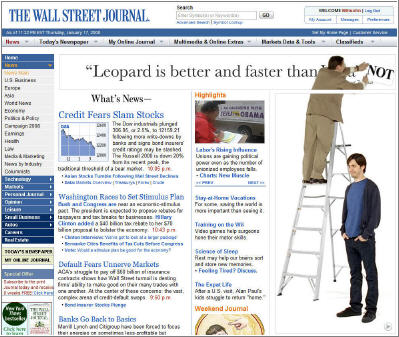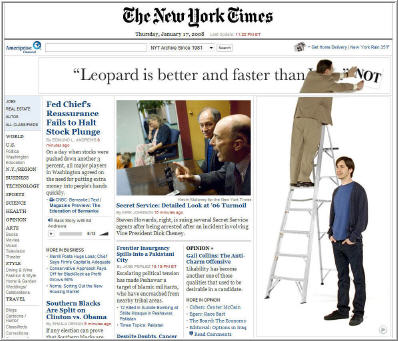-
"Mac vs. PC" Roadblocks on WSJ & NYT
Ending the week on a slightly lighter note, if you happened to go to WSJ.com or NYT.com yesterday, you would have seen that Apple bought out all the top of page ad inventory at both sites for its latest "Get a Mac" video spot (also known as the "Mac vs. PC" ads), which have been hugely popular on TV and online.


Apple's so-called "roadblock" strategy yesterday meant that every single visitor to these 2 sites were exposed to the same leaderboard/skyscraper video ad highlighting WSJ writer Walt Mossberg's opinion that Apple's latest Leopard OS release is "better and faster than Vista." Apple has a whole gallery of its "Get a Mac" ads here, though this new one is not yet posted.
In the online ad business, this type of video ad is referred to as "rich media." I haven't spent much time in VideoNuze discussing rich media ads, instead concentrating on pre-rolls and overlays ads which are actually adjacent to video content. Rich media ads show that there are many different ways to leverage video's emotional and informational impact even when there is no underlying video content to be adjacent to. Given the limitation of high-quality video content against which to run video ads, rich media has become an important and growing segment of the overall online ad business.
While, some rich media ads are way too "in your face" and spoil the user's experience, I think the way the yesterday's roadblock was executed is well within bounds. The video begins playing when the site loads, but the audio is muted. The user has to click the audio icon, and then the spot replays from the start. This means there's been an opt-in decision, which leads to higher engagement. Also, unlike many other rich media spots, the ad is composed solely of a leaderboard and skyscraper, so it doesn't have any obnoxious "pop-ups", "floating" or "expandable" components that block the underlying site content. These are the types of things that drive users crazy.
Rich media ads are an important part of the mix for fully understanding what's happening with video online, especially for advertisers who want to explore all options for leveraging video's emotional impact. I see the category continuing to grow. If ads are well-executed like Apple's, there will not only be minimal user pushback, but rather genuine opportunities for branding and interactivity.
Categories: Advertising
Topics: Apple


